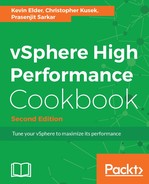There are three main decisions you need to make when designing your vCenter system.
The first decision is whether you are going to install vCenter on Windows or install vCenter server Appliance (VCSA). In vSphere Version 6.5, VCSA's capabilities are identical to the Windows version. Unlike the previous version, the 6.5 VCSA supports Update Manager. VCSA also supports the same number of ESXi hosts and VMs using its embedded PostgreSQL database. If you decide to use VCSA, you can skip this chapter and go to Chapter 8, Designing VCSA for Best Performance; if you want to install vCenter on Windows, read on.
The second decision is whether you are going to install the vCenter server on physical or virtual hardware. If you are going to install VCSA, the decision is already made—your vCenter will be virtual. One could argue that installing vCenter on a VM that runs on the same hardware that it is managing could be an issue. If the VMware host that runs vCenter fails, then the vCenter VM fails too. However, in VMware vSphere, you can easily mitigate that risk by putting your vCenter server on a vSphere HA Cluster. If the VMware host that runs the vCenter VM fails, then HA will restart the vCenter VM on another host. Running vCenter server on a VM has several benefits as well:
- It can be easily backed up and restored as a whole unit, unlike a physical machine.
- It can be moved to another ESXi host using vMotion for planned maintenance.
- It can be load balanced across hosts using the vSphere Distributed Resource Scheduler cluster.
- It can also be protected using vSphere HA.
- It can be protected more easily for disaster recovery, using SRM or other ways of replicating and failing over to the recovery site.
- For every other reason, you're already using VMs over physical machines.
The third decision you need to make is whether you are going to run the embedded PostgreSQL database or use an external database. If you are running VCSA, the only database option is the embedded PostgreSQL database. If you run vCenter on Windows, your external database can be Oracle or Microsoft SQL.
